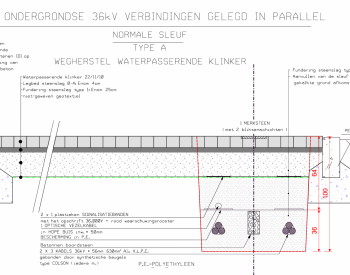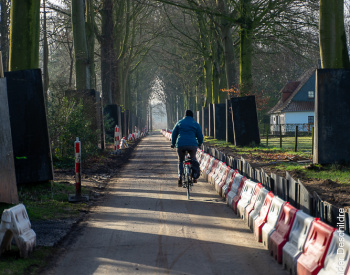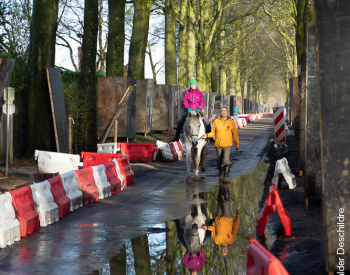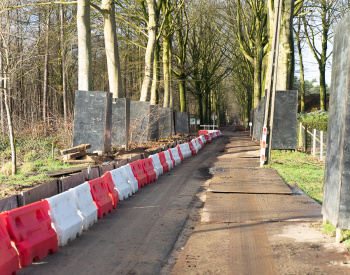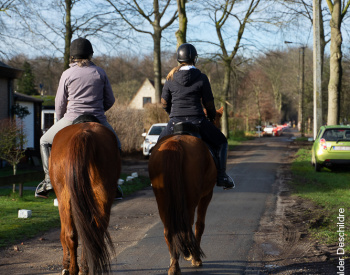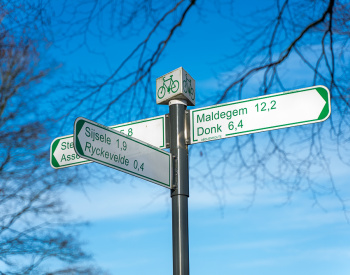Climate resiliant water permeable road in Damme
Since the existing electricity cables in Damme date from 1937 and thus reached the end of their operational viability, it was necessary for ELIA to provide new underground electricity cables. This renewal allows ELIA to continue to guarantee the supply of the Bruges region in the future. At the same time, Fluvius installed a separate sewage system. This meant that the road had to be completely redesigned from foundation to road surface. The City of Damme wanted to take the opportunity – in line with its principles of sustainable and climate-resistant design of the public domain – to work with ELIA on a unique sustainable synergy project between various contractors. Avalon Landscape + Engineering was appointed as designer for this realization as part of the assignment and, together with Stad Damme, Elia, Fluvius, Farys and APK Group, sought an optimal way of restoring infrastructure. It has become a unique project in Flanders. Location The works are located in Vossenberg and Rijckeveldestraat in Sijsele. They form the gateway to the Rijckevelde nature reserve. In addition to the forest and the Schobbenjak nature reserve, this 180-hectare domain, located on the border between Damme, Bruges and Beernem, also includes the former military domain and the castle Rijckevelde. Characterized by the large stately beech trees, the Vossenberg forms the connection for cyclists, traffic and residents between the Maalse Steenweg and the intersection with the Rijckeveldestraat. For example, a resolute choice was made to make the entire public domain more permeable, in which all facets of a water balance infrastructure are brought into synergy. A unique project in Flanders. As part of their assignment, Avalon Landscape + Engineering was appointed by ELIA as designer for this realization. This is in addition to their task of supervising the landscape restoration above the cable works. This meant that, together with the client and in dialogue with all actors, an optimal way of restoring infrastructure and surroundings after the cable works was sought. In the execution of this assignment by ELIA, an open dialogue with the road authority (in this case the City of Damme), sustainability principles, safety of the environment, users and residents and future-oriented design principles were central. Within the framework of these principles, the City of Damme, in consultation with ELIA, decided to radically change the local roads Rijckeveldestraat and Vossenberg. Both streets had been carried out in a water-impermeable pavement prior to the start of the works and there was also partly still a mixed sewerage system. Here and there there was even a direct discharge of gray water into the area. Synergy The aim was to minimize the impact of these works on residents and the environment. Sufficient financial resources were also made available by the parties involved to optimally start this synergistic realization. A consultation platform was set up to unite all actors involved in the implementation process. It was a solid and well-supported preparatory process, which definitely benefited the implementation and the preliminary studies. For example, the investigations and technical reports on earthmoving, archaeology, topography, geology and drainage were carried out in synergy and shared with each other. One of the joint conclusions that emerged was that lowering the groundwater level was not desirable. Due to the timing of the works in the spring, the negative impact on the mature trees and the nearby forest and nature reserve would be significant. Water-permeable road – circular economy When comparing the costs of this traditional implementation with those for the design of a water-permeable road, it appeared that no nominal higher cost was to be expected for the realization. This includes a foundation adapted for infiltration and buffering of the rainwater. In order to minimize the impact on the superficial roots of the adjacent beech trees, it was also decided not to break out more than necessary from the existing foundations and sub-foundations. A water-passing concrete paving stone with an open joint was chosen as the pavement. All this with the aim of guiding the rainwater that reaches the pavement as quickly as possible through the pavement layer to the foundation package where it is buffered and can infiltrate into the subsoil. In combination with this infiltration foundation and street layer, the water passing concrete paving stones withstand heavy rain showers. The better supply of air and water under the paved zone also benefits the trees directly and creates a better living environment. This offers great added value to the old and valuable trees. All these elements together make this a unique project in Flanders in sustainable and climate-resistant design of public domain
in uitvoering
ELIA ENGINEERING - Stad Damme
Sijsele - Damme

